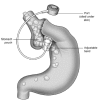Mechanisms of weight loss after gastric bypass and gastric banding
- PMID: 20057200
- PMCID: PMC6515913
- DOI: 10.1159/000232383
Mechanisms of weight loss after gastric bypass and gastric banding
Abstract
The obesity epidemic is a major health problem that is associated with increased morbidity and mortality. Gastrointestinal hormones have been increasingly understood to be an important element in appetite regulation. Several gastrointestinal hormones can contribute to obesity by modulating the activity of the gut-brain axis. Bariatric surgery is currently the most effective therapy for significant and sustained weight loss in morbidly obese patients. Understanding how gut hormones are altered by bariatric procedures has contributed to our understanding of the mechanisms of appetite. In this review, we address several gastrointestinal hormones that are associated with obesity and consider how their levels are altered after bariatric surgery. The review also addresses specific effects of different gut hormones on appetite, hunger, and energy balance.
Figures
Similar articles
-
[Why patients lose weight after bariatric operations].Zentralbl Chir. 2010 Feb;135(1):28-33. doi: 10.1055/s-0029-1224697. Epub 2010 Feb 5. Zentralbl Chir. 2010. PMID: 20140853 Review. German.
-
Mechanisms of disease: the role of gastrointestinal hormones in appetite and obesity.Nat Clin Pract Gastroenterol Hepatol. 2008 May;5(5):268-77. doi: 10.1038/ncpgasthep1118. Epub 2008 Apr 1. Nat Clin Pract Gastroenterol Hepatol. 2008. PMID: 18382432 Review.
-
Sir David Cuthbertson Medal Lecture. Bariatric surgery as a model to study appetite control.Proc Nutr Soc. 2009 Aug;68(3):227-33. doi: 10.1017/S0029665109001256. Epub 2009 Apr 29. Proc Nutr Soc. 2009. PMID: 19400971
-
Gastrointestinal hormones, energy balance and bariatric surgery.Int J Obes (Lond). 2011 Sep;35 Suppl 3:S35-9. doi: 10.1038/ijo.2011.146. Int J Obes (Lond). 2011. PMID: 21912386 Review.
-
Obesity, gut hormones, and bariatric surgery.World J Surg. 2009 Oct;33(10):1983-8. doi: 10.1007/s00268-009-0080-9. World J Surg. 2009. PMID: 19506944 Review.
Cited by
-
Recent advances in the modification of taste and food preferences following bariatric surgery.Rev Endocr Metab Disord. 2016 Jun;17(2):195-207. doi: 10.1007/s11154-016-9365-0. Rev Endocr Metab Disord. 2016. PMID: 27245858 Review.
-
[Metabolic surgery].Chirurg. 2012 Jun;83(6):583-598; quiz 599-600. doi: 10.1007/s00104-011-2239-9. Chirurg. 2012. PMID: 22695815 Review. German.
-
Influence of additional resection of the gastric fundus on excessive weight loss in laparoscopic very very long limb Roux-en-Y gastric bypass.Obes Surg. 2013 Mar;23(3):279-86. doi: 10.1007/s11695-012-0805-y. Obes Surg. 2013. PMID: 23135881
-
Bariatric surgery for obese adolescents - 'make assurance doubly sure'.Obes Facts. 2009;2(5):277-80. doi: 10.1159/000248714. Epub 2009 Oct 21. Obes Facts. 2009. PMID: 20057193 Free PMC article. No abstract available.
-
CORRELATION BETWEEN PRE AND POSTOPERATIVE LEVELS OF GLP-1/GLP-2 AND WEIGHT LOSS AFTER ROUX-EN-Y GASTRIC BYPASS: A PROSPECTIVE STUDY.Arq Bras Cir Dig. 2016 Nov-Dec;29(4):257-259. doi: 10.1590/0102-6720201600040010. Arq Bras Cir Dig. 2016. PMID: 28076481 Free PMC article.
References
-
- Allison DB, Saunders SE. Obesity in North America. An overview. Med Clin North Am. 2000;84:305–332. v. - PubMed
-
- Hedley AA, Ogden CL, Johnson CL, Carroll MD, Curtin LR, Flegal KM. Prevalence of overweight and obesity among US children, adolescents, and adults, 1999–2002. JAMA. 2004;291:2847–2850. - PubMed
-
- Visscher TL, Seidell JC. The public health impact of obesity. Annu Rev Public Health. 2001;22:355–375. - PubMed
-
- Kaplan LM. Pharmacological therapies for obesity. Gastroenterol Clin North Am. 2005;34:91–104. - PubMed
-
- Thearle M, Aronne LJ. Obesity and pharmacologic therapy. Endocrinol Metab Clin North Am. 2003;32:1005–1024. - PubMed
Publication types
MeSH terms
Substances
Grants and funding
LinkOut - more resources
Full Text Sources
Other Literature Sources
Medical



